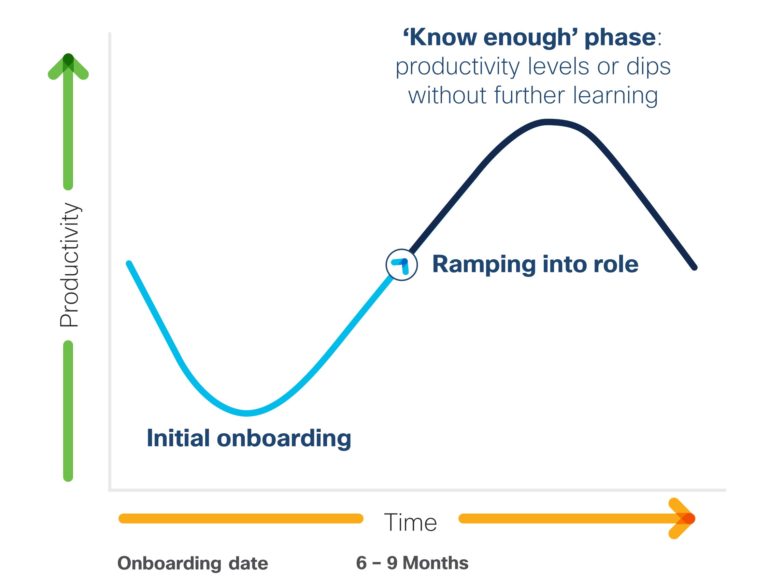A critical step to creating an enriching initial experience for new hires come into play during the onboarding process. What are the considerations to achieve high employee productivity and engagement?
Now that you have hired the highest potential talent, what’s next?
Whilst most companies deem onboarding to be a top component of the new hire experience, many are failing to build a strategy and a structure that enables their new employees to navigate successfully through the initial steps. As a result, attrition increases, the ramp-up or productivity curve flattens, and managers and employees alike are left disappointed at the new hire experience. On average, companies lose between 50% of their new hires in the first 12 months; one-third don’t even make it to 90 days.
In a recent Gallup poll, only 12% of employees strongly agreed that their organisation did a good job of onboarding. The general feedback suggests that to many managers, onboarding was about providing the employee with the basic set-up; i.e. a workspace, tools for the job, as well as basic training and orientation. The best new employee experiences cited a longer-term process, with high engagement and check-in from their manager, structured training and development, plus a well thought out mentoring program.
Right now, the onboarding process has become even more critical, with many new employees hired directly into a virtual or remote working environment. This poses new challenges to organisations, who in turn need to adapt their processes and programs to support the initial experience of an employee who has no face to face contact with their manager and co-workers, and who in turn can feel very isolated and under-supported.
As such a critical component in achieving high employee productivity and engagement, what are the practical considerations a company should consider in their onboarding strategy?
1. Start the onboarding experience during the hiring process: It sounds counter-intuitive, but highly motivated applicants will learn as much as possible about the company before interviewing. By providing quality information through the hiring process, this can in turn accelerate the onboarding of successful candidates.
2. Onboarding is not an induction course: In Cisco, our experience indicates that new employees often go through different “waves” of productivity and engagement during their first 18 months with the company. The best onboarding programs focus on activities and levels of support to capture these waves. For example, the first 30 days obviously require high levels of learning and support. However, many employees hit a lull after 6-9 months, when they ‘know enough’ but are still far from their productivity peak. This is a key inflection point for companies to capture the next level of development and mentoring. Without this, many employees start to feel abandoned, lose motivation and seek alternative opportunities.

3. Onboarding is not just the manager’s responsibility: Whilst the Gallup panel survey showed that employees were 3 times more likely to feel the success of their onboarding program when their manager was heavily engaged, the best onboarding programs also include senior leaders, supervisors and various team members. In fact, employees who are involved in onboarding new hires often feedback that it is rewarding and motivating. Additionally, this also helps the new hire build a wide support network, gain diverse perspectives and knowledge, as well as feeling that the broader company is invested in their success.
4. Consider the learning styles of your new hires: Often overlooked, companies will build out an onboarding program based on an intensive orientation program and vast libraries of articles and slideware. The most effective learning comes from shorter bursts of interactive and visually engaging content. Consider short on-demand video learning, Q&A (Ask The Expert) sessions and gamification, together with routine one on one check-ins. These can all be achieved successfully in a virtual or remote working environment
5. Have a launch and a close for your onboarding experience: Whilst the beginning of an onboarding program usually involves a flurry of activity, it’s easy for it to tail off after a few weeks, leaving the new hire confused as to where they are at and the progress they have made. Spend time on a closure to the program too, with either a graduation or small celebration. New hires also feel camaraderie with peers and colleagues who went through the program at the same time. By creating a new hire community, lasting peer relationships can be formed that can also accelerate the onboarding ramp-up experience.
Successful onboarding of new hires plays a critical role both in employee productivity ramp-up and retention. However, many companies still fail to focus enough attention on getting a robust onboarding strategy and execution plan. In a world of increased virtualisation of teams, it is more essential than ever to get this piece of the new hire experience right; those that do will see higher employee engagement, lower rates of attrition and a faster leap to productivity.
In the meantime, you can also browse my previous post for Cisco Viewpoints relating to Managing the Evolving Workforce or check out our most recent posts.
Connect with my team and me on LinkedIn here:
good
Caring for your employees doesn’t end after the onboarding phase. If you want to ace employee retention, you need a culture that fosters it. Read more to understand how you can prioritise employee wellbeing. https://www.peoplehum.com/blog/employee-retention-how-to-ace-employee-retention
Through the process of onboarding, you will help new talent find their place in the company, both in terms of job responsibilities as well as within organizational culture. During this process, the employee should begin to investigate and assess whether the company is a workable match for him or her.
I’m currently taking a college course on Recruitment and Selection. The textbook didn’t really give me a strong sense of what makes a good onboarding. In fact, the materials refer to Cisco’s onboarding approach. I really enjoyed this article. It gave me a better sense of the elements that go into a great onboarding program. Thanks! D. Ellis